Portal:Martial arts/Selected picture
Selected pictures list
Selected picture 1
Portal:Martial arts/Selected picture/1
 |
Boxing is a combat sport and martial art. Taking place in a boxing ring, it involves two people – usually wearing protective equipment, such as protective gloves, hand wraps, and mouthguards – throwing punches at each other for a predetermined amount of time.
Although the term "boxing" is commonly attributed to western boxing, in which only fists are involved, it has developed in different ways in different geographical areas and cultures of the World. In global terms, "boxing" today is also a set of combat sports focused on striking, in which two opponents face each other in a fight using at least their fists, and possibly involving other actions, such as kicks, elbow strikes, knee strikes, and headbutts, depending on the rules. Some of these variants are the bare-knuckle boxing, kickboxing, Muay Thai, Lethwei, savate, and sanda. Boxing techniques have been incorporated into many martial arts, military systems, and other combat sports.
Humans have engaged in hand-to-hand combat since the earliest days of human history. The origins of boxing in any of its forms as a sport remain uncertain, but some sources suggest that it has prehistoric roots in what is now Ethiopia, emerging as early as the sixth millennium BC. It is believed that when the Egyptians invaded Nubia, they adopted boxing from the local populace, subsequently popularizing it in Egypt. From there, the sport of boxing spread to various regions, including Greece, eastward to Mesopotamia, and northward to Rome. (Full article...)
Selected picture 2
Portal:Martial arts/Selected picture/2
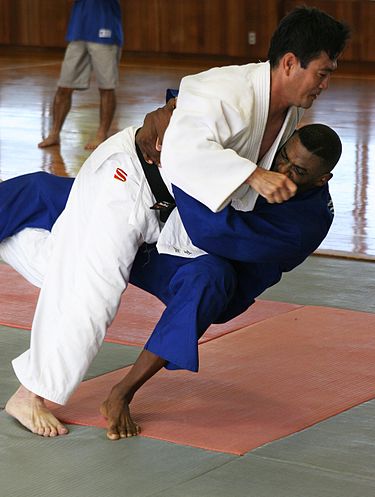 |
Judo (Japanese: 柔道, Hepburn: Jūdō, lit. 'gentle way') is an unarmed modern Japanese martial art, combat sport, Olympic sport (since 1964), and the most prominent form of jacket wrestling competed internationally. Judo was created in 1882 by Kanō Jigorō (嘉納 治五郎) as an eclectic martial art, distinguishing itself from its predecessors (primarily Tenjin Shinyo-ryu jujutsu and Kitō-ryū jujutsu) due to an emphasis on "randori" (乱取り, lit. 'free sparring') instead of kata (形, kata, pre-arranged forms) alongside its removal of striking and weapon training elements. Judo rose to prominence for its dominance over established jujutsu schools in tournaments hosted by the Tokyo Metropolitan Police Department (警視庁武術大会, Keishicho Bujutsu Taikai), resulting in its adoption as the department's primary martial art. A judo practitioner is called a "judoka" (柔道家, jūdōka, lit. 'judo performer'), and the judo uniform is called "judogi" (柔道着, jūdōgi, lit. 'judo attire'). (Full article...)
Selected picture 3
Portal:Martial arts/Selected picture/3
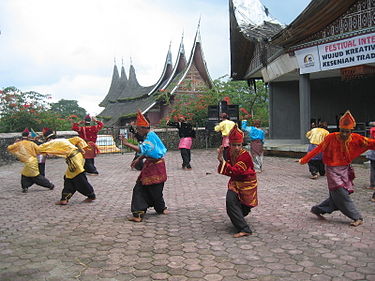 |
Randai (Jawi: رنداي) is a folk theater tradition of the Minangkabau ethnic group in West Sumatra, Indonesia, which incorporates music, singing, dance, drama and the martial art of silat. Randai is usually performed for traditional ceremonies and festivals, and complex stories may span a number of nights. It is performed as a theatre-in-the-round to achieve an equality and unity between audience members and the performers. Randai performances are a synthesis of alternating martial arts dances, songs, and acted-out scenes. Stories are delivered by both the acting and the singing and are mostly based upon Minangkabau legends and folktales. Randai originated early in the 20th century out of a fusion of local martial arts, story-telling, and other performance traditions. Men originally played both the male and female characters in the story, but since the 1960s, women have also participated. (Full article...)
Selected picture 4
Portal:Martial arts/Selected picture/4
 |
Fencing is a combat sport that features sword fighting. The three disciplines of modern fencing are the foil, the épée, and the sabre (also saber); each discipline uses a different kind of blade, which shares the same name, and employs its own rules. Most competitive fencers specialise in one discipline. The modern sport gained prominence near the end of the 19th century and is based on the traditional skill set of swordsmanship. The Italian school altered the historical European martial art of classical fencing, and the French school later refined that system. Scoring points in a fencing competition is done by making contact with an opponent. (Full article...)
Selected picture 5
Portal:Martial arts/Selected picture/5
 |
Senegalese wrestling (Njom in Serer, Lutte sénégalaise or simply Lutte avec frappe in French, Làmb in Wolof, Siɲɛta in Bambara) is a type of folk wrestling traditionally performed by several African tribes, from the Wolofs of West Africa to the Nuer and Dinka of South Sudan. and now a national sport in Senegal and parts of The Gambia, and is part of a larger West African form of traditional wrestling (fr. Lutte Traditionnelle). The Senegalese form traditionally allows blows with the hands (frappe), the only one of the West African traditions to do so. As a larger confederation and championship around Lutte Traditionnelle has developed since the 1990s, Senegalese fighters now practice both forms, called officially Lutte Traditionnelle sans frappe (for the international version) and Lutte Traditionnelle avec frappe for the striking version. (Full article...)
Selected picture 6
Portal:Martial arts/Selected picture/6
 |
Archery is the sport, practice, or skill of using a bow to shoot arrows. The word comes from the Latin arcus, meaning bow. Historically, archery has been used for hunting and combat. In modern times, it is mainly a competitive sport and recreational activity. A person who practices archery is typically called an archer, bowman, or toxophilite. (Full article...)
Selected picture 7
Portal:Martial arts/Selected picture/7
 |
Since the 1970s, there has been a revival of traditional or reconstructed methods of swordsmanship (劍術 geom sul, or 劍法 geom beop) based on the Korean sword in the Republic of Korea (Korean Bon Kuk Geom Beop 본국검법 "National Sword Methods"), supplementing the practice of Kumdo (the Korean adoption of modern Japanese Kendo). There are historical sources on which such reconstructions are based, dating to the 17th and 18th centuries, notably the Muyejebo (“Martial Arts Illustrations”) of 1610, its 1759 revision Muyeshinbo, supplemented with 12 additional fighting methods by Prince Sado who originated the term Sip Pal Ki (“Eighteen Fighting Methods”), and the renewed revision of 1790, Muyedobotongji. (Full article...)
Selected picture 8
Portal:Martial arts/Selected picture/8
 |
Mixed martial arts (MMA) is a full-contact fighting sport based on striking and grappling, incorporating techniques from various combat sports from around the world. (Full article...)
Selected picture 9
Portal:Martial arts/Selected picture/9
 |
A foil is one of the three weapons used in the sport of fencing. It is a flexible sword of total length 110 cm (43 in) or under, rectangular in cross section, weighing under 500 g (18 oz), with a blunt tip. As with the épée, points are only scored by making contact with the tip. The foil is the most commonly used weapon in fencing. (Full article...)
Selected picture 10
Portal:Martial arts/Selected picture/10
 |
The épée (/ˈɛpeɪ, ˈeɪ-/, French: [epe]; lit. 'sword'), also rendered as epee in English, is the largest and heaviest of the three weapons used in the sport of fencing. The modern épée derives from the 19th-century épée de combat, a weapon which itself derives from the French small sword.
As a thrusting weapon, the épée is similar to a foil (contrasted with a sabre, which is designed for slashing). It has a stiffer blade than a foil. It is triangular in cross-section with a V-shaped groove called a fuller. The épée also has a larger bell guard designed to protect the user’s arm. In addition to the larger "bell" guard and blade, the épée weighs more than the foil and sabre which contributes to its reputation of being the slowest form of fencing. The techniques of use differ, as there are no rules regarding priority and right of way. Thus, immediate counterattacks are a common feature of épée fencing. The entire body is a valid target area. (Full article...)
Selected picture 11
Portal:Martial arts/Selected picture/11
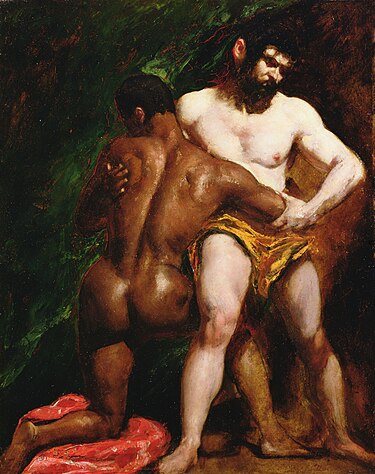 |
The Wrestlers is an oil painting on millboard by English artist William Etty, painted around 1840 and currently in the York Art Gallery, in York, England. It depicts a wrestling match between a black man and a white man, both glistening with sweat and under an intense light emphasising their curves and musculature. While little documentation of the painting exists prior to 1947, it is likely that it was painted over a period of three evenings at the life class of the Royal Academy. (Full article...)
Selected picture 12
Portal:Martial arts/Selected picture/12
 |
Wrestlers is a name shared by three closely related 1899 paintings by American artist Thomas Eakins, (Goodrich catalog #317, #318, #319). The Los Angeles County Museum of Art (LACMA) owns the finished painting (G-317), and the oil sketch (G-318). The Philadelphia Museum of Art (PMA) owns a slightly smaller unfinished version (G-319). All three works depict a pair of nearly naked men engaged in a wrestling match. The setting for the finished painting is the Quaker City Barge Club (defunct), which once stood on Philadelphia's Boathouse Row. (Full article...)
Selected picture 13
Portal:Martial arts/Selected picture/13
 |
Salutat is an 1898 painting by Thomas Eakins (1844–1916). Based on a real-life boxing match that occurred in 1898, the work depicts a boxer waving to the crowd after the match. According to Eakins' biographer Lloyd Goodrich, Salutat is "one of Eakins' finest achievements in figure-painting." The painting's title is Latin for "He greets" or "He salutes." (Full article...)
Selected picture 14
Portal:Martial arts/Selected picture/14
 |
Dempsey and Firpo (sometimes referred to as Dempsey Through The Ropes) is an oil-on-canvas painting executed in 1923–1924 by the American artist George Bellows. It depicts the September 14, 1923, boxing match between American Jack Dempsey and Argentine Luis Firpo. It has become Bellows' most famous boxing painting. The work has been in the collection of the Whitney Museum of Art since the museum's opening in 1931. (Full article...)
Selected picture 15
Portal:Martial arts/Selected picture/15
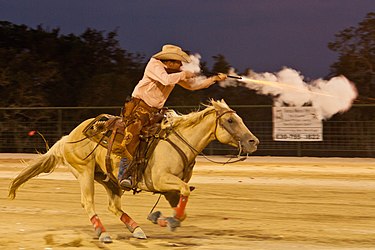 |
Cowboy mounted shooting (also called western mounted shooting and mounted shooting) is a competitive equestrian sport involving the riding of a horse to negotiate a shooting pattern. Depending on sponsoring organizations, it can be based on the historical reenactment of historic shooting events held at Wild West shows in the late 19th century. Modern events use blank ammunition instead of live rounds, certified to break a target balloon within twenty feet (6 m). (Full article...)
Selected picture 16
Portal:Martial arts/Selected picture/16
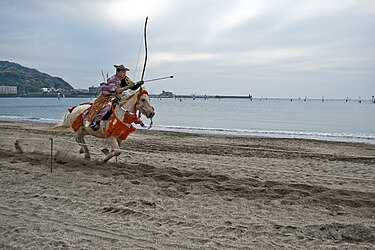 |
Yabusame (流鏑馬) is a type of mounted archery in traditional Japanese archery. An archer on a running horse shoots three special "turnip-headed" arrows successively at three wooden targets.
This style of archery has its origins at the beginning of the Kamakura period. Minamoto no Yoritomo became alarmed at the lack of archery skills his samurai possessed. He organized yabusame as a form of practice. (Full article...)
Selected picture 17
Portal:Martial arts/Selected picture/17
 |
A jump kick is a type of kick in certain martial arts and in martial-arts based gymnastics, with the particularity that the kick is delivered mid-air, specifically moving ("flying") into the target after a running start to gain forward momentum. In this sense, a "Jump kick" is a special case of a flying kick, any kick delivered in mid-air, i.e. with neither foot touching the ground.
Flying and jump kicks are taught in certain Asian martial arts, such as karate, kenpo, kalarippayattu, kung fu and taekwondo. (Full article...)
Selected picture 18
Portal:Martial arts/Selected picture/18
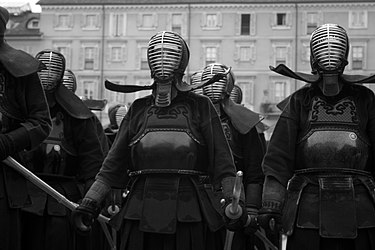 |
Kendo (剣道, Kendō, lit. 'sword way', 'sword path' or 'way of the sword') is a modern Japanese martial art, descended from kenjutsu (one of the old Japanese martial arts, swordsmanship), that uses bamboo swords (shinai) as well as protective armor (bōgu). It began as samurai warriors' customary swordsmanship exercises, and today, it is widely practiced within Japan and has spread to many other nations across the world. (Full article...)
Selected picture 19
Portal:Martial arts/Selected picture/19
 |
Kata (Japanese: 形, or more traditionally, 型; lit. "form") is a Japanese word describing detailed patterns of movements practiced either solo or in pairs. Karate kata are executed as a specified series of a variety of moves, with stepping and turning, while attempting to maintain perfect form. The kata is not intended as a literal depiction of a mock fight, but as a display of transition and flow from one posture and movement to another, teaching the student proper form and position, and encouraging them to visualise different scenarios for the use of each motion and technique. Karateka "read" a kata in order to explain the imagined events, a practice known as bunkai. There are various kata, each with many minor variations. (Full article...)
Selected picture 20
Portal:Martial arts/Selected picture/20
 |
Water jousting is a form of jousting where two jousters, carrying a lance and protected only by a shield, stand on a platform on the stern of a boat. The aim of the sport is to send the opponent into the water whilst maintaining one's own balance on the platform. The boat is propelled by oarsmen or, in some cases, a motor may be used. The sport is practised principally in France, but it also exists in parts of Switzerland and Germany. (Full article...)
Usage
The layout design for these subpages is at Portal:Martial arts/Selected picture/Layout.
- Add a new Selected picture to the next available subpage.
- Update "max=" to new total for its {{Random portal component}} on the main page.
